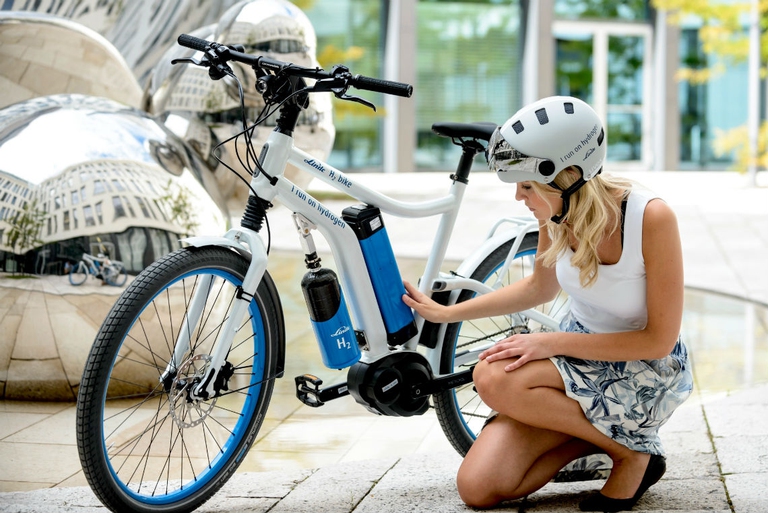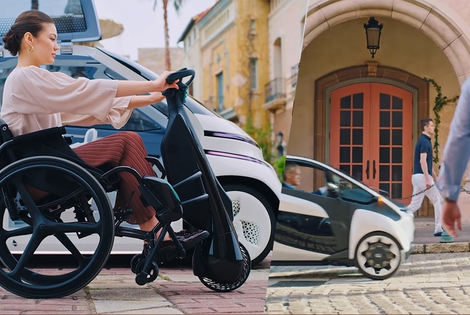
Milan has announced one of Europe’s most ambitious mobility schemes, known as Strade Aperte (open roads). Its goal is to reduce cars in phase 2 of the lockdown by increasing bike lanes and pedestrian areas.
Linde Group ha testato il primo prototipo di bicicletta a pedalata assistita a idrogeno. Niente pacco batterie, al suo posto una ricarica di H2.
It has no batteries, but a hydrogen fuel cell able to produce electricity. It is the H2 bike, a functioning e-bike prototype which uses about 30 grams of hydrogen fuel and oxygen taken from the surrounding air to produce electricity for the assisted pedalling.
It has been realised by engineers of the Linde Group, German multinational committed to developing hydrogen technologies. The e-bike can travel up to 100 kilometres on a single tank, with no emissions.
“Linde is pushing new and unconventional ideas to contribute to the widespread commercialisation of hydrogen as a clean technology,” commented Wolfgang Büchele, CEO of Linde. “With the Linde H2 bike, we have shown that the benefits of hydrogen drives are not restricted to cars – bikes are another interesting application”. The group is strongly committed to developing hydrogen technologies, both for producing sustainable gas and creating a quick, safe recharge network.
As the company underlines, hydrogen has to be produced with energy from renewable sources, in order it to be sustainable from an energy and environmental point of view. An example of that is the Energiepark Mainz in Germany, where Siemens, in collaboration with Linde, has realised a plant to produce hydrogen fuel from wind energy. There, the gas is produced to be used as fuel, as well as to store extra energy coming from neighbouring wind farms.
H2 bike. Photo Linde.
By employing hydrogen technologies, there’s no need of using lithium batteries, the group said, because spent batteries have to be processed and managed not to become hazardous waste.
For now, H2 bike is only a limited series, realised in just 3 months. But we believe that hydrogen e-bikes could be soon part of our everyday life.
Siamo anche su WhatsApp. Segui il canale ufficiale LifeGate per restare aggiornata, aggiornato sulle ultime notizie e sulle nostre attività.
![]()
Quest'opera è distribuita con Licenza Creative Commons Attribuzione - Non commerciale - Non opere derivate 4.0 Internazionale.
Milan has announced one of Europe’s most ambitious mobility schemes, known as Strade Aperte (open roads). Its goal is to reduce cars in phase 2 of the lockdown by increasing bike lanes and pedestrian areas.
Formula 1, the world’s most important auto racing championship, has decided to turn the page and aim for carbon neutrality with the support of its teams, drivers and the whole racing circus.
Toyota and LifeGate began telling the story of hybrid mobility back in 2006, now, on the road to the Tokyo 2020 Olympics, they’re still treading the path of sustainable mobility. Here are the main steps of the journey.
Germany’s first solar bicycle lane could be the prototype for the roads of the future. The photovoltaic tiles melt snow and ice, and are capable of absorbing noise.
The Vespa is back in an electric version. Production has just started and the first models can be reserved online starting from October.
The city of Utrecht, in the Netherlands, is home to a bridge for cycling and walking that stretches over roof garden of a Montessori school. This project enhances practicality and will allow families to bring children to school by bike, passing through green areas. Despite their functionality, bridges are often seen as an infrastructure that is
The Lego hair bike helmet is the latest Internet craze. For now it’s just a prototype but production on a large scale will probably start soon.
Just as fires often give way to new growth, after the Dieselgate scandal, which saw Volkswagen cheating on US emission rules, the German car manufacturer radically changed course, beginning to focus on sustainable mobility. The German car company aims to propose thirty zero-emission models and produce at least one million battery electric vehicles by 2025. An ambitious mission
Sustainable, two-wheel mobility is triumphing in Copenhagen. After years of investments, policies, and infrastructural changes, bikes now outnumber cars in the city centre. The website Copenhagenize has released data linked to the number of vehicles entering the city centre, which are monitored by the city’s administration on a daily basis. Last year, 265,700 bikes have entered








